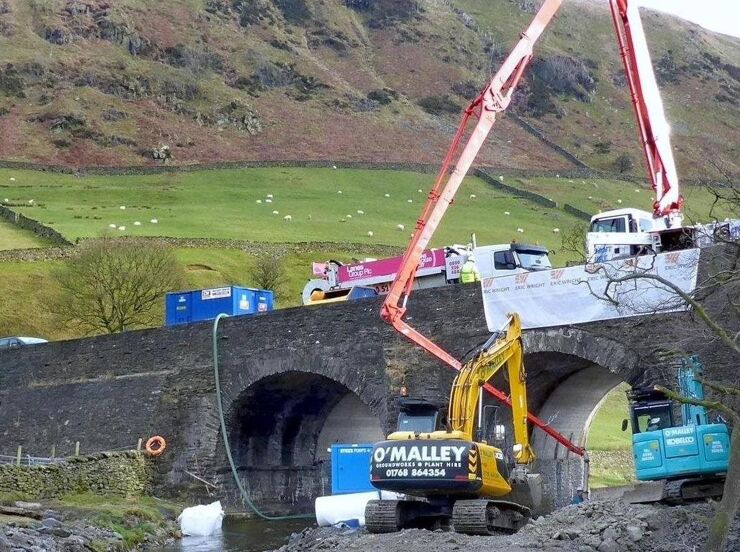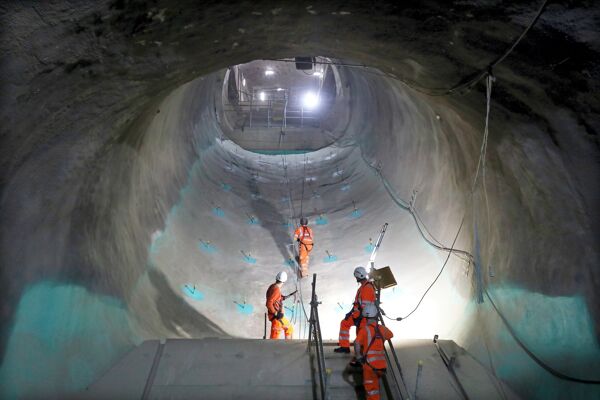
Storm Desmond wreaked havoc across north-west England in December 2015, with Cumbria county receiving a record 405mm rainfall in 48 hours. The floods that followed damaged over 600 bridges and more than 2,500km of carriageways – leading to a three-and-a-half-year NEC-procured infrastructure recovery programme.
Following receipt of significant funding from the Department for Transport, Cumbria County Council started a £120 million programme in January 2016 to repair, replace and add resilience to over 1200 individual bridge, carriageway and slope schemes across the county. Completion is scheduled for December 2019.
The overall programme and project management of the infrastructure recovery works is being undertaken by a partnership between the council and Mott MacDonald. The two organisations have established a fully integrated, co-located and jointly staffed programme management team based in Carlisle.
Individual works packages are being carried out using NEC3 Engineering and Construction Contract (ECC) Options A (priced contract with activity schedule), C (target contract with activity schedule) and E (cost reimbursable contract). By the midway point, there were over 60 live ECC contracts covering more than 600 individual schemes with a combined value in excess of £45 million.
Aligning Behaviours
According to Nick Raymond, the council’s senior manager for infrastructure recovery and major programmes, ‘Understanding the programme-level requirements and success factors from day one enabled us to design an over-arching supply-chain blueprint. This involved adopting ECC Options A, C and E, providing an optimum platform for greater behavioural alignment with the supply chain and promoting establishment of a delivery community.
‘NEC3 contracts have been the backbone to our behavioural step-change in contract and project delivery. They provide an environment where all our supply chain share learning, best practice and add value, such as through involvement in shaping project-level contracting strategies.’
He says the council’s framework suppliers include both national and local contractors with differing levels of internal contract governance. ‘Using the NEC across the whole programme along with deployment of standard programme controls has ensured consistency of approach across the supply chain. This has supported the development of a ‘Cumbria infrastructure recovery’ ethos and style within the programme.’
Emergency Works Phase
Given the emergency nature of works in the first year, a substantial volume of ECC Option E contracts were used. ‘This was largely unchartered territory for the council,’ says Raymond. ‘Through the integration of Mott MacDonald’s NEC3 ECC Accredited Project Managers, we embraced the change and achieved significant success. Large parts of our network were returned back to temporary and permanent functionality within a relatively short space of time.’
He says the cost-reimbursable payment mechanism of ECC Option E brings obvious commercial risks for the client. ‘However, the combination of a truly collaborative framework environment with the main contractors, sound commercial management and early introduction of a collaborative web-based contract management environment enabled these risks to be managed and the delivery programme to be driven while ensuring good value for money.’
In year two, the scope requirements were matured and refined. ‘This enabled us to change the pricing mechanism to ECC Option A and C target contracts, where a more balanced view of risk and reward could be taken,’ says Raymond.
Early Contractor Involvement
He says early contractor involvement was recognised from the outset as a key enabler to successful project delivery. ‘It was coupled with the adoption of a two-stage design-and-build procurement process, which minimised risk and buildability issues, and maximised certainty for both the outturn cost and delivery schedules.
‘Also, by minimising the number of Z clauses, we have tried to remain as true as we can to the spirit and intent of NEC. Our NEC3 ECC Accredited Project Managers have ensured a firm but fair and diligent operation of our contractual obligations.
‘Project management has been further underpinned with the use of an electronic NEC3 contract management tool, which provides a real-time single version of the truth, thus ensuring all parties are clear on their contractual performance. Using NEC in this way has ensured traditional contractual disputes are minimised and issues are dealt with along the way.’
Innovative Package Procurement
Having such a large volume of individual schemes at varying levels of maturity spread throughout the county provided a catalyst for the council to procure and contract in a very different manner. Using a web-based geographic information system, the council bundled schemes into work packages based on geographic location, characteristics and complexity. The majority contained over 30 individual schemes at varying levels of maturity.
‘Knowing we could not wait until the last scheme was at a level of commercial and/or technical maturity to enter into contract, we designed, developed and piloted the use of a process called ‘progressive asset release’,’ says Raymond. ‘This enabled us to tender and let work packages where only a handful of schemes were of a level of maturity to enter into contract.
‘We built in placeholders for the other schemes to facilitate their eventual inclusion once commercially ready to contract. The NEC compensation event and schedule of cost components made this innovation easily deployable with minimal legal redrafting.’
Benefits of Using NEC
- NEC facilitated unprecedented collaboration within the project team, enabling the client to procure the optimum solution and maximise value for money.
- Use of the NEC3 suite of contracts for all parts of the supply chain provided a consistency of contract management and fostered a whole-team approach to delivery.
- NEC provided a framework for improved contract management – embracing the early warning and compensation event process ensured that issues were dealt with in a timely manner and that there were no surprises at the end of the contract.
- NEC compensation event and schedule of cost components process facilitated phased procurement of packages with minimal legal redrafting.



